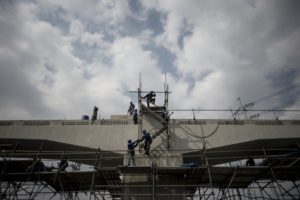In the race to build a new international airport to eventually replace the congested Ninoy Aqino International Airport in Manila, the province of Cavite is settling on a new strategy to hasten the approval of its proposal.
The Inquirer learned that the Cavite government, which had submitted an offer to build a P508-billion airport complex on a reclaimed land in Sangley Point, had proposed on May 24 to pursue its plan under the local Public-Private Partnership (PPP) Code.
The Department of Transportation, in a letter dated June 6, said it had “no objection” to the project being implemented in that manner.
This means the international air hub will be pursued as a joint venture between investors, including Chinese enterprises, and the Cavite LGU.
This scheme will no longer require the approval of the National Economic and Development Authority, with the power to approve reclamation projects reverted to the Office of the President with the signing of Executive Order 74 in February.
In its letter, the DOTr said the Cavite government would still need to secure clearance from the Civil Aviation Authority of the Philippines and the Manila International Airport Authority to coordinate flights between the two air hubs.
“It is also with the understanding that the project will not involve any government guarantee, subsidy or equity in any form or depth in the implementation,” the DOTr said.
The Cavite government’s offer, dubbed the Sangley Point International Airport, could see its first phase operational in three to four years.
According to documents submitted to the Neda on Dec. 17, Phase 1 involves the opening of one runway and a capacity of 25 million passengers.
Expansion will come in phases that will see it eventually have four runways and an annual capacity of 135 million passengers—the internal forecast beyond 2040. The proposal also includes a “connector bridge” that will cut travel time between Sangley and Makati to 30 minutes.
The Cavite government also has serious competitors in its bid to shape the future of air traffic in Manila, where much of the country’s economy and politics is centered.
Since 2016, the DOTr has received an offer from seven conglomerates to expand the Naia and a proposal from San Miguel Corp. to build a new airport in Bulacan.


